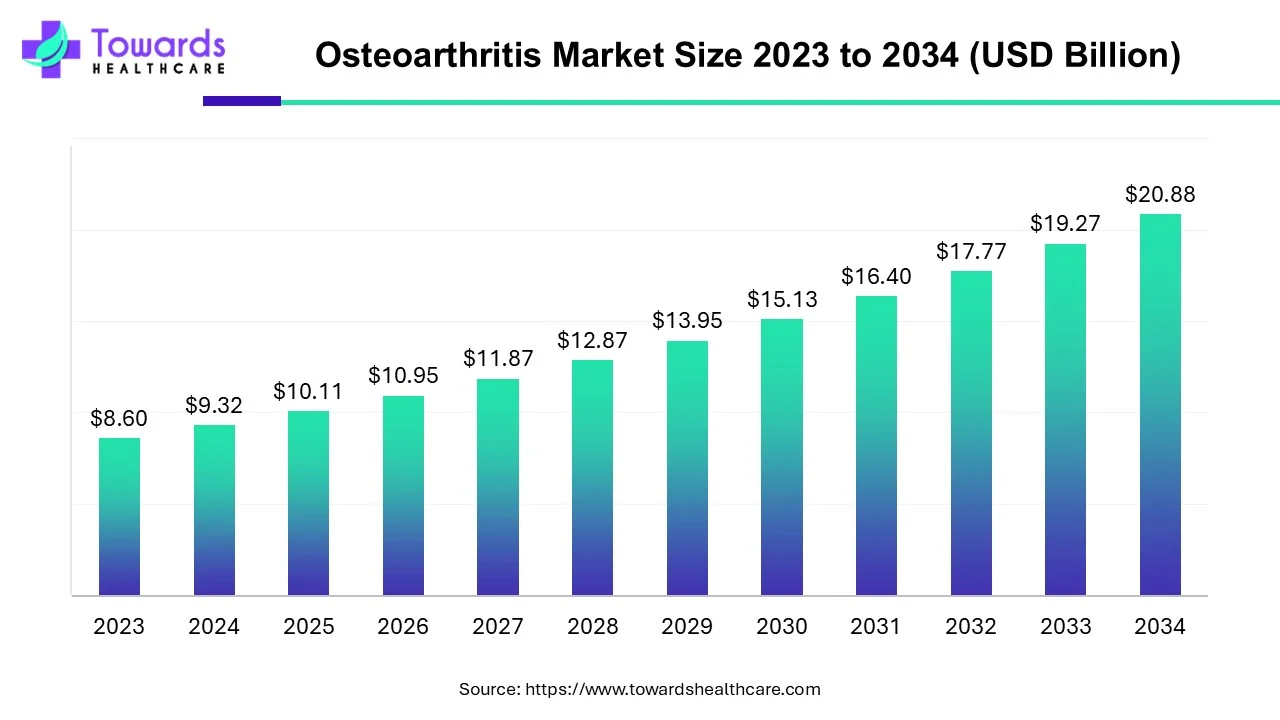Osteoarthritis Market Analysis Key Trends, Drivers and Growth Forecast (2024 – 2032)
Table of Contents
ToggleOsteoarthritis Market Growth, Trends, and Key Companies (2024 – 2032)
The osteoarthritis market is expected to grow significantly, from USD 8.60 billion in 2023 to approximately USD 19.15 billion by 2032, reflecting a compound annual growth rate (CAGR) of 8.4% during the forecast period from 2024 to 2032.

Download statistics of this report @ https://www.towardshealthcare.com/download-statistics/5136
Osteoarthritis Market Overview: Key Insights and Trends
In 2023, knee osteoarthritis was the leading cause of wear and tear in the market, accounting for more than 49% of the total share. Imaging tests played a dominant role in diagnosing the condition, holding a significant market share. North America stood out with a substantial 38% market share in the same year. According to the Centers for Disease Control and Prevention (CDC), osteoarthritis made up 2.5% of all health issues in 2023, contributing to 20% of the overall burden of musculoskeletal conditions.
Globally, osteoarthritis affects around 3.3% to 3.6% of people and is a major cause of disability for approximately 43 million individuals, ranking it as the 11th most disabling condition worldwide. In the United States, around 80% of people aged 65 and older show signs of osteoarthritis on X-rays, but only 60% experience symptoms. This discrepancy occurs because changes observed in X-ray images do not always directly correlate with the joint pain a person feels.
Osteoarthritis is a common joint disorder where the cartilage that protects the bones wears down over time. This can cause pain, stiffness, and reduced flexibility in affected joints, such as the hands, hips, and knees.
Key Factors Contributing to Osteoarthritis:
- Age: The risk of developing osteoarthritis increases with age.
- Sex: Women are more likely to develop osteoarthritis after the age of 50 compared to men.
- Obesity: Excess weight puts added stress on joints, especially those that bear weight, such as the knees and hips, increasing the risk of osteoarthritis. Additionally, obesity may lead to metabolic changes that further raise the risk.
- Genetics: A family history of osteoarthritis increases the likelihood of developing the condition.
In 2020-21, approximately $4.3 billion was spent on osteoarthritis care, representing 2.9% of total healthcare spending and 29% of the spending on all musculoskeletal conditions.
While osteoarthritis is not curable, proper treatment is essential to manage symptoms, improve joint function, and enhance quality of life. Treatment strategies include lifestyle changes like exercise and weight management, medications to manage pain and inflammation, and, in some cases, surgery. Early diagnosis and intervention are critical to slowing disease progression and maintaining an active lifestyle.
Our Table of Content (TOC) covers key healthcare market segments, materials, technologies and trends—helping you navigate market shifts and make informed decisions: https://www.towardshealthcare.com/table-of-content/osteoarthritis-market-sizing
Access exclusive insight now @ https://www.towardshealthcare.com/price/5136
We’ve prepared a service to support you. Please feel free to contact us at sales@towardshealthcare.com
Web: https://www.towardshealthcare.com
Visit Dental Specifics: https://www.towardsdental.com
Get the latest insights on industry segmentation with our Annual Membership: Get a Subscription
For Latest Update Follow Us: https://www.linkedin.com/company/towards-healthcare



